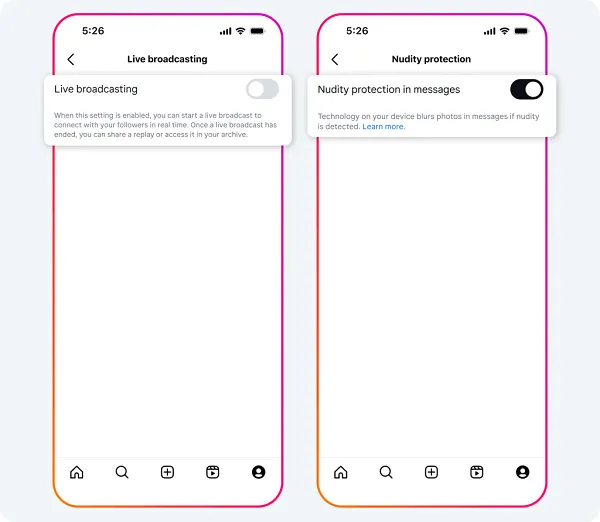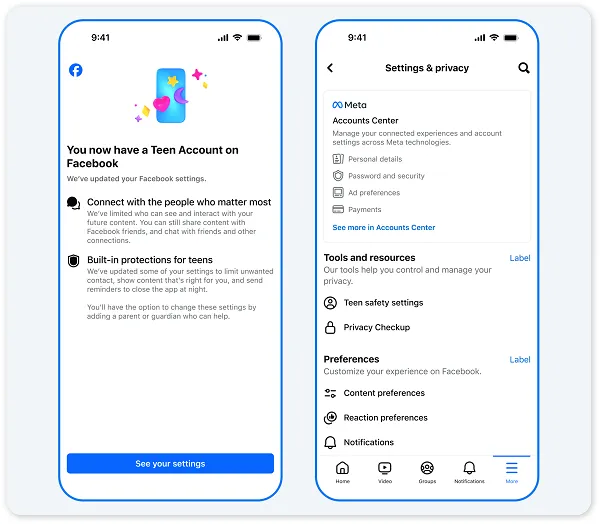Meta’s rolling out some new protecting parts for teen customers, together with restrictions on dwell streaming on IG, superior safety inside DMs, an growth of its teen accounts to Fb and Messenger, and extra.
The updates will guarantee safer experiences for teen customers, and are a constructive step. And with Meta persevering with to return below scrutiny over the dangers that its apps pose to teenagers, it might additionally assist to exhibit its dedication to enchancment on this entrance.
First off, Instagram’s implementing new restrictions for live-streaming and its DM safety parts, which is able to imply that folks will now have to approve any adjustments to the default settings.
As defined by Instagram:
“Along with the present built-in protections supplied by Teen Accounts, we’re including new restrictions for Instagram Stay and undesirable photographs in DMs. With these adjustments, teenagers below 16 might be prohibited from going Stay until their mother and father give them permission to take action. We’ll additionally require teenagers below 16 to get parental permission to show off our characteristic that blurs photographs containing suspected nudity in DMs.”

Stay-streams could be a dangerous proposition for younger customers, with the rapid engagement eliminating filtering instruments, leaving them open to publicity and manipulation. As such, this can be a good replace, which is able to assist to make sure that mother and father preserve extra consciousness of their teen’s on-line exercise.
Meta’s additionally making its Teen Accounts out there on Fb and Messenger, which is able to replicate Instagram’s teen profiles which it launched final yr.
“Teen Accounts on Fb and Messenger will provide comparable, automated protections to restrict inappropriate content material and undesirable contact, in addition to methods to make sure teenagers’ time is properly spent. We’ll start rolling Fb and Messenger Teen Accounts out to teenagers within the US, UK, Australia and Canada and can carry the expertise to teenagers in different areas quickly.”

The adjustments are the most recent security replace for teen customers, with IG including enhanced privateness parts, messaging restrictions, sleep mode, dangerous content material publicity limits, and extra final yr alone.
And Instagram says that its teen safety options are having an impression.
“Since making these adjustments, 97% of teenagers aged 13-15 have stayed in these built-in restrictions, which we consider provide probably the most age-appropriate expertise for youthful teenagers.”
So whereas teenagers can decide out of a few of these parts, the info exhibits that they’re not doing so, with Instagram’s teen accounts additionally giving mother and father extra oversight into their baby’s app use.
So why is Meta making these adjustments now?
Properly, ideally, you’d wish to assume that it’s to make sure teen wellbeing and security, however provided that Meta is usually extra targeted on, properly, what advantages Meta, I’d view these with a extra skeptical eye.
Final yr, the U.S. Surgeon Common referred to as for cigarette-like labels on social media to warn of the potential psychological well being dangers, whereas the Senate additionally handed the Children On-line Security Act to impose extra stringent security and privateness necessities for youngsters and youngsters on social media.
In August, a teen filed a $5 million lawsuit in opposition to Meta over its implementation of addictive algorithmic options, whereas a variety of lawsuits have been additionally filed by the attorneys normal of 45 U.S. states, accusing Meta of unfairly concentrating on youngsters and youngsters on Instagram and Fb, whereas additionally utilizing misleading techniques to minimize hazards.
Internationally, a number of areas are additionally seeking to improve the age at which youngsters are capable of entry social media attributable to issues about its destructive impacts, and with all of those issues in thoughts, it’s laborious to imagine that Meta is just seeking to do what’s proper.
However regardless of the purpose, primarily based on the rising proof that factors to the harms brought on by social media platforms, this does look like a constructive step. Although whether or not it will likely be sufficient to stem the tide in opposition to Zuck and Co. on this entrance stays to be seen.
It stays a major space of concern, and with increasingly educational analysis highlighting the hyperlinks between social media use and psychological well being impacts, it additionally raises extra questions in regards to the push for innovation, and the “transfer quick and break issues” method that Silicon Valley leaders typically favor to take.
The explanations for this are market forces and worldwide competitors, and the necessity for U.S. firms to prepared the ground on all fronts. However on the similar time, accelerating improvement means overlooking the dangers, whereas it additionally gives direct incentives for platforms with mass attain and affect to disregard or obfuscate such issues within the identify of progress.
Sadly, we’re now seeing the very same occur within the AI race, in addition to VR improvement, with American tech platforms seeking to push again on rules to get their newest improvements out to the general public earlier than anyone else. However what are the psychological well being impacts of facilitating human relationships with digital beings? What would be the eventual harms brought on by AI bots participating with consumer posts in social apps?
Will VR environments be extra dangerous for psychological well being, given their extra immersive nature?
At a guess, I’d say that these developments will find yourself being a destructive impression for a lot of customers, simply as social media has been, and even when you can argue that the positives do outweigh the harms, it’s nonetheless the harms that ought to be getting extra focus.
So, sure, this newest teen security replace is a constructive, however it’s not essentially a voluntary transfer from Meta, and we nonetheless have an extended strategy to go in factoring in such issues versus accelerated improvement.



